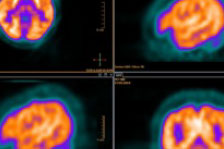Neuroimaging
Following a brain injury, clinicians may use imaging tests to see inside the brain. Imaging tests can show abnormalities, such as blood clots or brain bleeds, as well as show the individual's actual brain function. It is important to note that NOT all brain injuries show up on neuroimaging; many milder injuries are cellular and cannot be detected with this type of technology.
There are several types of imaging available. These are the most commonly utilized:
 Computed Axial Tomography
Computed Axial Tomography
Computed Axial Tomography (CAT or CT) scans produce cross-sectional pictures to create 3-D brain images that show the brain's density and any abnormalities, such as swelling, bleeds (called hematomas), and skull fractures.
Though not as sensitive as MRI scans, CT scans take less time to perform and are typically the first scans taken in the hospital.
 Magnetic Resonance Imaging
Magnetic Resonance Imaging
Magnetic resonance imaging (MRI) scans produce detailed images of the brain using radio waves and a strong magnetic field. MRI scans typically take longer to obtain than CT scans, but they are more sensitive and provide more detail.
They are not typically done in immediate care (emergency department or intensive care unit) or during the initial treatment after a brain injury.
 Computed Tomography Angiography
Computed Tomography Angiography
CT angiography or CTA provides the treatment team with images of blood vessels in the brain and throughout the body to show blockages or abnormalities.
 X-ray
X-ray
X-rays allow the treatment team to locate any skull fractures or other broken bones as a result of the injury.
 Electroencephalogram
Electroencephalogram
An electroencephalogram or EEG is a test that measures the electrical activity in a person's brain. This test is usually done to determine the amount of brain activity and to detect any suspected seizure activity.
 Functional Neuroimaging
Functional Neuroimaging
Functional neuroimaging tests create pictures of the brain's activity during various tasks. These studies may include SPECT (single photon emission computerized tomography) and PET (position emission tomography) scans.
Questions?
Consult your physician for more information on neuroimaging and whether or it not can be beneficial for you.
